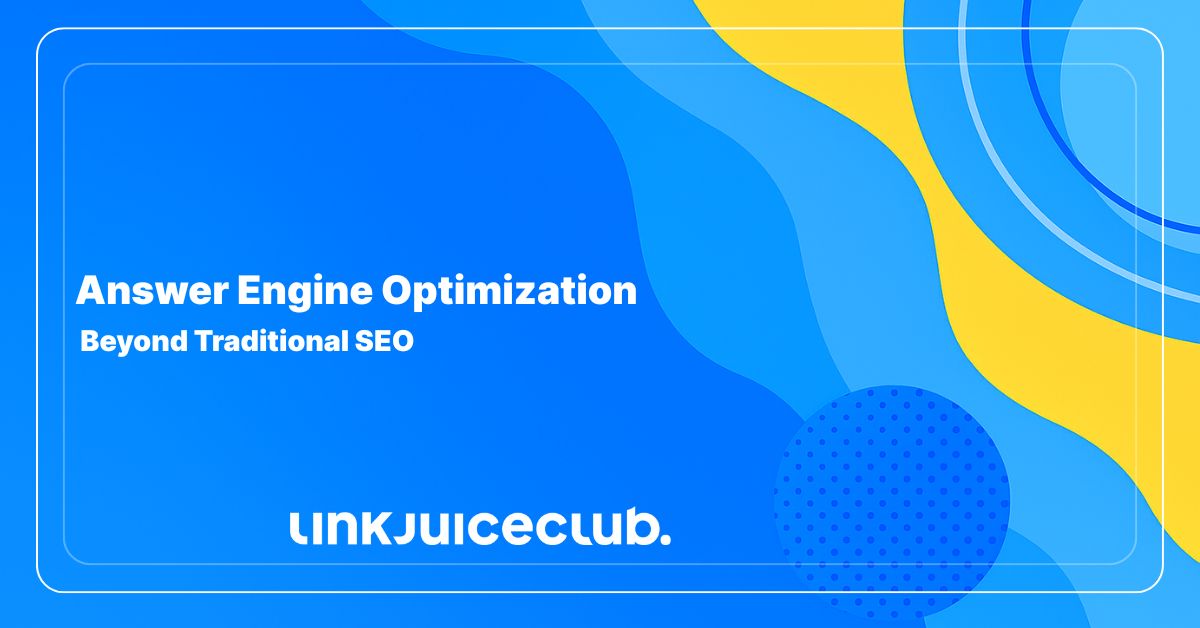
Answer Engine Optimization: Beyond Traditional SEO
Search is getting a facelift. Google? Still around. But now, users are skipping the scroll and asking ChatGPT, Perplexity, and Microsoft Copilot straight-up questions (and expecting instant answers).
This is what Answer Engine Optimization (AEO) is all about. Showing up in blue links isn’t the goal anymore. You want your brand to be quoted, cited, and recommended by the machines doing the answering.
This isn’t your grandma’s SEO. It’s part strategy, part structure, and all about teaching AI to love your content. That means clearer formatting, smarter schema markup, content that screams I know what I’m talking about, and backlinks that seal the deal.
AEO vs. SEO: Same Battlefield, Different Weapons
If you think Answer Engine Optimization is just SEO with a fancy hat, think again. These two might share some DNA, but they operate in very different playgrounds.
Traditional SEO is all about ranking on search engines like Google, while AEO is your golden ticket to getting quoted by AI-powered answer machines like ChatGPT, Perplexity, and Microsoft Copilot.

Knowing when to speak Google’s language and when to feed answers to AI tools can give your brand a huge edge in the visibility game.
AEO
Answer Engine Optimization focuses on content that answers questions clearly, directly, and conversationally.
It’s less about ranking and more about being selected. You’re not climbing the SERP; you’re aiming for citations and mentions within AI-generated responses.
To win at AEO, your content needs to be structured in a way that’s digestible by large language models. That means using clear subheadings, natural language, semantic clarity, and concise answers. You’re creating content that feels helpful to humans but is also machine-readable.
SEO
SEO, on the other hand, is all about winning over algorithms like Google’s. It’s keyword-driven, crawl-based, and still obsessed with on-page factors like title tags, meta descriptions, backlinks, site speed, and content freshness.
With SEO, you’re trying to convince search engines that your page deserves a spot on page one, preferably at the top.
Unlike AEO, which aims to appear inside AI-generated answers, SEO is more about building content around specific search intent. That means researching what your audience types into Google (like best coffee shops in Amsterdam) and crafting optimized pages to match that demand.
So, while AEO leans into natural questions, SEO often targets high-volume keywords, and aims to convert searchers into visitors – and hopefully, customers.
But This Doesn’t Mean SEO and AEO Are Completely Different
Search Engine Optimization and Answer Engine Optimization may live on different platforms, but they do have a few things in common.
Same Goal: Be Where the People Are
Whether it’s SEO helping your site climb to the top of Google or AEO getting your content quoted by Perplexity or Copilot, the endgame is the same: visibility.
Both disciplines exist to position your brand front and center.
The medium might change, but the mission doesn’t. It’s all about meeting users at the exact moment they’re looking for something you can offer.
Similar Tactics: Content Is Still King (and Schema Is Queen)
SEO and AEO might wear different outfits, but their toolkits are incredibly similar. We’re talking authentic, helpful content, keyword targeting, and of course, backlinks from trusted sources.
Shared Skill Sets: From Word Nerds to Data Geeks
If you’re good at SEO, you’re probably halfway to mastering AEO. Why? Because the foundational skills (like understanding your audience, crafting useful content, and tracking performance) translate almost perfectly between the two.
Writing with clarity, thinking strategically, and presenting data? That’s your bread and butter in both worlds. The playground may be different, but the game’s still about being helpful, relevant, and smart with your content.
Why Answer Engine Optimization Actually Matters (a Lot)
As we could see, users are now getting direct, polished answers from AI assistants. So, these platforms don’t just suggest content, they become the content.
AI Search Is More Than Hype
AI-powered tools are already shaping how people search, shop, and solve problems. Just look at the numbers:
- OpenAI’s products? Over 400 million users per week.
- Millennials? Nearly half of them are turning to social media as their go-to search engine.
Users Are Searching Smarter
Even as organic traffic slips, revenue is climbing for many brands. That’s because users are moving their attention elsewhere.
Basically, people are skipping the extra clicks and going straight to the answer. If your content isn’t showing up where those answers live, it’s not reaching the user – plain and simple.
Playing the Long Game Means Playing Smart
Brands that start optimizing for answer engines now are building a serious edge. Early adoption doesn’t just mean better visibility today; it sets you up to dominate as AI platforms become the new standard in digital discovery.
So, AEO isn’t a replacement for SEO. It’s a necessary evolution.
Why AEO Isn’t Exactly a Walk in the Park
Answer engine optimization is exciting, but let’s not pretend it’s easy. It comes with its own set of challenges that make even experienced marketers scratch their heads.

You Can’t Track What You Can’t Measure (Yet)
One of the biggest headaches with AEO? The lack of reliable tracking tools. With SEO, we’ve got all the goodies – Google Search Console, Ahrefs, Semrush – to tell us what’s working and what’s not.
AEO? Not so much.
There’s no clear way to see how often your brand gets mentioned in ChatGPT or Copilot. No click-through rates. No easy traffic graphs. You’re mostly working with assumptions and indirect signals, which makes optimization feel like trial and error. That’s frustrating when you’re trying to prove results to your team!
Getting Internal Support Isn’t Always Easy
AEO is a new mindset. And not everyone’s ready to jump on board. Since it doesn’t replace SEO, businesses need to invest alongside their existing efforts. That usually means asking for extra budget or shifting resources.
It’s Not One Platform. It’s a Whole Crowd
Traditional SEO is mostly about one thing: Google. AEO, on the other hand, is about many answer engines at once, like ChatGPT, Gemini, Claude, Perplexity, and Meta AI.
Each one has its own way of picking answers, which means your content has to adapt to different styles and systems. It’s a juggling act, and it takes more effort to get right!
AEO Demands Better Content (Yes, Even Better Than Before)
Google’s been telling us to write helpful content for years, but answer engines raise the bar even higher. These platforms don’t want basic tips or recycled advice.
They want depth, clarity, and unique insights, the kind of stuff users actually need.
If your content is vague or generic, it’s going to be ignored. Answer engines pick up on specificity, so you need to go beyond surface-level writing and deliver real value.
AEO Results: Not Instant, But Definitely Worth It
So, how long does it take for answer engine optimization to kick in?
The short answer: anywhere from a few weeks to a few months. The long answer? It really depends on how much SEO groundwork your site has already laid down.
If your site already ranks well in Google, gets crawled regularly, and has a good content foundation, you’re off to a solid start. Because a strong SEO base means the heavy lifting (visibility, trust, relevance) is already happening.
Websites that are already doing things like:
- Earning credible backlinks from relevant sources
- Publishing content that speaks directly to their niche audience
- Showing up in search and being crawled by AI platforms
- Managing active local listings and social profiles
…are simply better positioned to make an impact with AEO from day one.
But if your brand is just now stepping into the world of optimization? No problem. Just don’t skip ahead. Start with traditional SEO, nail the basics, and then gradually shift gears into answer engine territory.
We’re No Longer Playing in Google’s Backyard Alone!
The internet has expanded its horizons, and now we’re optimizing for bots that talk back. That’s the game-changer.
Answer engine optimization doesn’t mean tossing SEO in the bin; it’s about leveling up. Same fundamentals, new playing field.
So if your brand’s goal is to be part of the conversation (not just found, but featured), then now’s the time to adapt, experiment, and lead. Because in a world full of answers, the real winners are the ones who get quoted.





